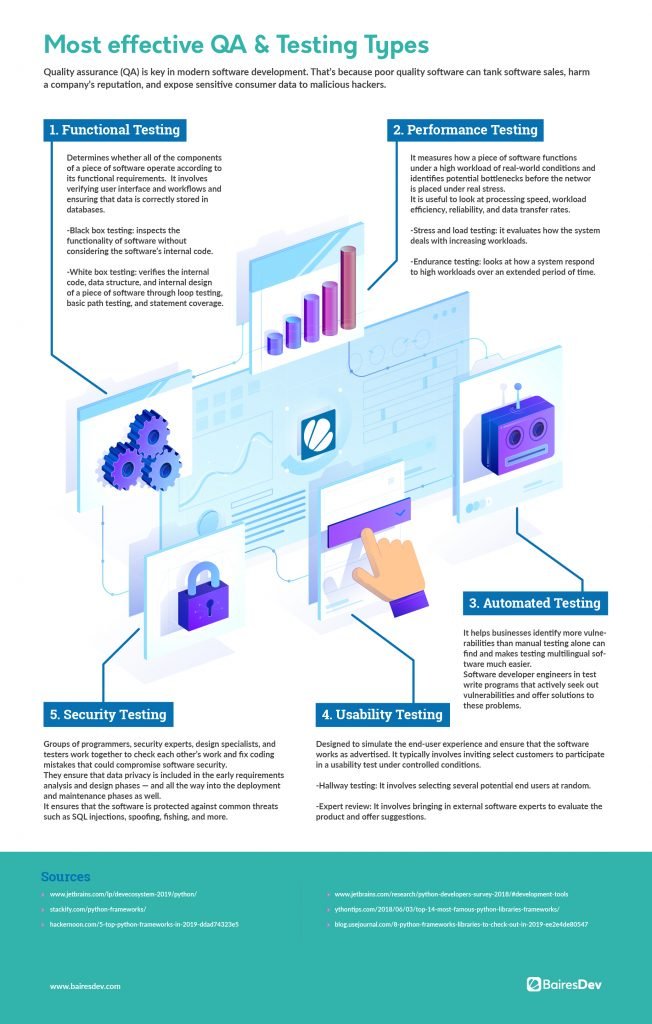Software Quality Assurance (QA) works by continuously testing and monitoring software products throughout the development process. In essence, the role of software QA services is to push the limits of an application in various directions and provide businesses with valuable insights that lead to higher-quality products.
QA processes introduce the “human factor” to code-based testing by creatively anticipating what the user would do, even if it goes beyond the purposes of the application. This way, software developers are able to fully understand all of its functionality and integration points.
Currently, organizations of all sizes work with QA & Testing services to guarantee that their product is properly designed and implemented, and that is able to perform beyond what’s expected. Ultimately, this mitigates downtime and errors in the final product, while also providing a far better User Experience.
The Core QA Process Stages
Design
The QA process begins as soon as the product spec starts. This test-driven development approach is crucial to trace out initial user flows since the early stages of development. Guided by the product bones, the development team will save lots of time and effort.
Implementation
Long-lasting quality is guaranteed by applying thorough and organized unit testing. As the project takes shape, some exploratory testing can take place and continue to refine the product flow. The key is to quickly combine a wide Continuous Integration (CI) process with crowdsourcing and automation, yielding high-quality data and preventing issues from snowballing.
Testing
Finding issues means fixing issues. Adopting a strategic triage approach will help the development team prioritize every task and categorize them accordingly. Keeping track of all tasks and their progress is essential for the project to move on without ignoring relevant concerns.
Maintenance
Long-lasting quality is guaranteed by applying thorough and organized unit testing. As the project takes shape, some exploratory testing can take place and continue to refine the product flow. The key is to quickly combine a wide Continuous Integration (CI) process with crowdsourcing and automation, yielding high-quality data and preventing issues from snowballing.
Benefits of Adopting a QA Process
Anticipates Fatal Issues
Problems that arise with certain software, especially with those that operate with sensitive data, can lead to communication breakdowns, massive blackouts and data leaks. Testing and QA makes sure there is no room for errors.
Saves Money
Prevention is key and early detection of bugs and issues avoids great costs further along the line. It is much more expensive to fix problems when the development process is advanced and even worse if the product is finished.
Focuses On Unparalleled User Experience
UX ensures the delivery of flawless software: simple, easy to use, intuitive, free of errors, and efficient. A detailed testing process will guarantee customers are presented with a valuable, reliable and highly-interactive end-product.
Inhibits targeted attacks
Continuous testing maintains and upholds software security, eliminating weaker pieces of code and errors. Reliable and trustworthy products should always be a priority.
5 Types of QA Testing

Characteristics of a Great QA Process
Integrated
A great QA process integrates well with the development team’s workflow throughout the entire product’s lifecycle. This way, testing protocols can take place on all the tools and platforms different teams use.
Personalized
Different projects require different QA solutions that fit the company’s needs. Applying more QA doesn’t always translate into better products—driving each process with specific goals is far more valuable than stacking lots of them in the hopes of better results.
Automated
From quick testing to prioritization of results, QA tasks have always been somewhat manual. It is the development team’s job to effectively identify what can and should be automated.
Cross-functional
Every team and department in a company has a stake in the QA process. A cross-functional input approach will introduce higher-quality insights into the project and build-up to a far better end result.
Anticipative
Every company changes its needs and processes from time to time. A great QA process anticipates growth and is designed for both scalability and flexibility to fit new scenarios.
Measured
What is measured, improves. Collecting quality insights, identifying key metrics, and using them strategically will heavily impact all decisions regarding the product, the team, and the process.
Getting Started With QA Services
Businesses often lack in-house staff with access to the right amount of time or resources needed to lead comprehensive QA testing. Today, numerous companies rely on software testing & QA outsourcing to boost the quality of their products, trusting an expert overview of specialized professionals.
At BairesDev, we offer full Software Testing & QA Services to help you work in a smarter way, reducing risks and maximizing the quality of your final product.







